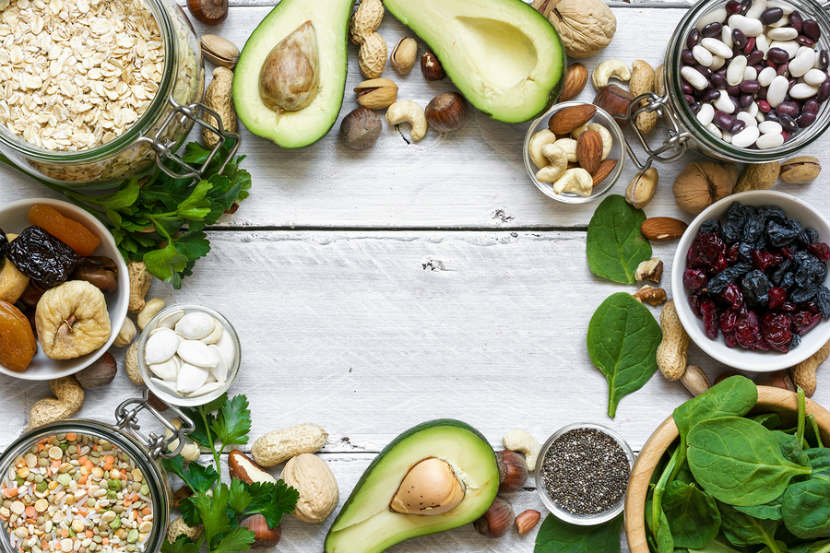
Magnesium is an important mineral that your body needs to be healthy. It helps to keep your heart healthy by working with other minerals to control blood pressure. Magnesium also helps keep your muscles, bones and nerves healthy. Read on to learn more about what foods have magnesium and how much you need.
How much magnesium do I need?
The amount of magnesium you need depends on your age, sex and life stage. The table below shows you how much you need:
Age
|
Magnesium
Amount needed per day
|
|
Men 19 to 30
|
400 mg
|
|
Women 19 to 30
|
310 mg
|
|
Men 31 and older
|
420 mg
|
|
Women 31 and older
|
320 mg
|
|
Pregnant women 19 to 30
|
350 mg
|
|
Pregnant women over 30
|
360 mg
|
|
Breastfeeding women 19 to 30
|
310 mg
|
|
Breastfeeding women over 30
|
320 mg
|
At any age, it is important to have no more than 350 mg of magnesium per day from supplements. Magnesium from food and water is safe to have above this amount.
Food sources of magnesium
Legumes, nuts, seeds, fish, leafy greens and whole grains are the best sources of magnesium.
The table below shows foods that contain magnesium:
Food
|
Serving Size
|
Magnesium (mg)
|
|
Pumpkin or squash seeds
|
60 mL (1/4 cup)
|
307
|
|
Brazil nuts
|
60 mL (1/4 cup)
|
133
|
|
Sunflower seeds
|
60 mL (1/4 cup)
|
129
|
|
Black-eyed peas/cowpeas
|
175 mL (3/4 cup)
|
121
|
|
Soy cheese
|
50 g (1 ½ oz)
|
114
|
|
All Bran cereal
|
30 g (1/3 cup)
|
83 to 111
|
|
Almonds
|
60 mL (1/4 cup)
|
88 to 109
|
|
Soy nuts
|
60 mL (1/4 cup)
|
99
|
|
Tofu (prepared with magnesium chloride or calcium sulphate)
|
175 mL (3/4 cup)
|
55 to 99
|
|
Wheat germ cereal
|
30 g (1/3 cup)
|
96
|
|
Beans (any variety)
|
175 mL (3/4 cup)
|
58 to 89
|
|
Prickly pear
|
1 fruit
|
88
|
|
Spinach
|
125 mL (1/2 cup)
|
83
|
|
Swiss chard
|
125 mL (1/2 cup)
|
80
|
|
Soy yogurt
|
175 g (3/4 cup)
|
70
|
|
Bran flakes cereal
|
30 g
|
49 to 69
|
|
Edamame/baby soy beans
|
125 mL (1/2 cup)
|
52
|
|
Potato with skin
|
1 medium
|
47 to 52
|
Do I need a magnesium supplement?
No. A healthy individual does not need a magnesium supplement if they are following Canada’s Food Guide. Scientists have not seen any benefit in taking magnesium supplements for health issues like lowering blood pressure, lowering the risk of heart disease or preventing bone loss. If you are at risk for getting high blood pressure, you should eat a diet rich in magnesium along with potassium and calcium. The bottom line is that it’s best to get the magnesium you need from food.
At any age, it is important to have no more than 350 mg of magnesium per day from supplements. Magnesium from food and water is safe to have above this amount.
Meal and snack ideas
-
Add legumes to your diet more regularly.
-
Add nuts and seeds to baked goods, yogurt, salads, granola and cereal.
-
Try a delicious nut butter like almond or cashew nut butter for a satisfying spread.
-
Read about these nutritious and delicious vegetables and great ways to add them to your diet.
-
Try this magnesium rich swiss chard and navy bean soupfor a filling lunch.
-
Choose whole wheat breads instead of white bread.
-
Add bran flakes or bran buds to your cereal or yogurt.
Try these other nutritious recipes that are rich in magnesium:
Toasted pumpkin-seed brittle
Sweet chilli tofu stir-fry
Tea poached salmon with fruit salsa
You may also be interested in:
What you need to know about calcium
All about beans
Last Update – March 21, 2019